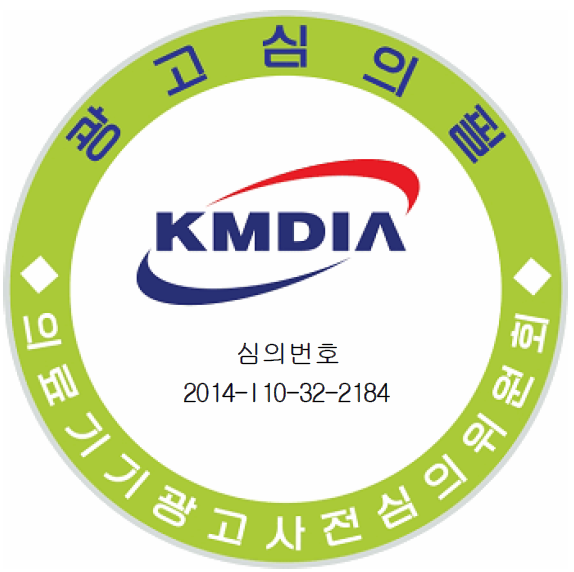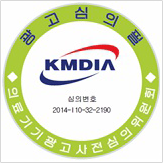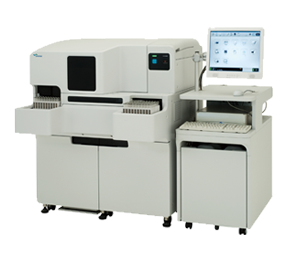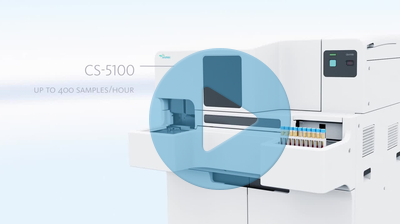복합 항목에서 고속처리를 실현하여 TAT(Turn Around Time)를 개선
응고법, 합성기질법, 면역비탁법의 기본 3가지 측정법에, 응집법을 더한 4가지 측정 원리를 실현했습니다. 모든 측정항목의 검출부를 통일화함으로써 높은 처리능력을 실현하였습니다.
*응집법은 교반 기능을 갖춘 8채널에서 동시 측정 가능
새로운 검출방식 탑재・충실한 검체 정보 그래프를 통한 고정밀 데이터 제공
멀티 웨이브 검출 방식에 의해 반응 프로세스를 5파장으로 검사합니다. 측정 항목별로 가장 적합한 파장을 자동 선택하여 측정하고 신뢰성 높은 데이터를 제공합니다. 또한, HIL 측정가능을 추가하였으며, 검사전에 검체의 상태를 측정함으로써, 용혈(H), 황달(I), 지방검체(L)의 검체정보를 그래프로 표시합니다.
캡 피어싱 기능・미량 대응으로 생물학적 위험 감소
캡 피어싱 기능을 탑재하여, 생물학적 위험을 저하 시킵니다. 또한, 클로징 튜브/ 오픈 튜브/ 샘플컵 혼재에도 대응합니다. 아울러 미량 모드를 탑재하여 보다 적은량의 검체만으로 검사를 가능합니다.
간단하고 안전한 시약 측정을 실현
40개의 모든 시약장착부는 바코드 자동 판독을 할 수 있습니다. 시약, 캘리브레이터, 정도관리물질을 랜덤으로 셋팅해도 시약명, 롯트 번호, 사용 기한 등의 정보를 자동 인식하여 표시하기 때문에,간단 하고 안전하게 시약 측정을 합니다. 또한, 시약 테이블 내 공기 순환형, 히터 설비 커버를 채용하여 온도의 균일화(10℃±2℃)뿐만 아니라 시약 테이블 아래의 냉각 매체에 이슬 맺힘을 집중시켜서 결로 현상을 방지합니다. 또한 시약 테이블 내부와 외부의 공기순환을 감소, 사용환경에 좌우되지 않는 구조로 하여서 시약증발을 억제하고 시약의 안정성을 향상시켰습니다.
"이 제품은 "의료기기"이며, "사용상의 주의사항"과 "사용방법"을 잘 읽고 사용하십시오"
광고심의필: 2014-I10-32-2184


이 제품은 "의료기기"이며, "사용상의 주의사항"과 "사용방법"을 잘 읽고 사용하십시오
광고심의필 : 심의번호 2014-I10-32-2184
No compromise on quality
Using four different detection technologies, the CS-5100 delivers great quality analyses. With clotting, chromogenic, immunoturbimetric and platelet aggregation assays it delivers accuracy and precision for all parameters. Clotting method The CS-5100 uses the Optical Detection Method to detect the change in turbidity of the sample-reaction mixture during the coagulation process. This is reflected in the change in scattered light intensity when fibrinogen is converted into a fibrin mesh. Light strikes the reaction mixture, after the scattered light intensity is received by a photodiode. This converts the light intensity into electrical signals and is used to find the coagulation time. This method is used to measure prothrombin time, APTT, fibrinogen, factors and many other clotting tests. Chromogenic method Light with a wavelength of 405 nm passes through the sample and reagent mixture and reaches a photodiode, where the transmitted light is converted into electrical signals. The change in the intensity of this transmitted light is used to determine the change in absorbance. This measurement is used for chromogenic assays like Antithrombin and Protein C where a chromogenic substrate in presence of an activator causes the reagent mixture to change colour. Immunoassay and platelet aggregation method The sample-reagent mixture contains artificial particles that can aggregate when there is an antigen-antibody reaction or particles that have a natural capability to aggregate like platelets. The mixture is exposed to light of a high wavelength, and the change in light absorbance caused by the formation of aggregates is detected as the change in transmitted light. This is used for D-dimer assays and platelet aggregation assays (Von Willebrand activity, ADP, Collagen, Arachidonic Acid, Epinephrine).
Get it right before you start testing – pre-analytical sample integrity helps
Pre-analytical issues can account for as much as 70% of a clinical laboratory’s errors. Multi-wavelength scanning and sample liquid-sensing technologies detect unsuitable specimens. A pre-analytical sample integrity check tests for interfering substances in the sample – haemolysis, icterus, lipaemia – at three wavelengths: 405 nm, 575 nm and 660 nm.
A primary tube sample volume check provides assistance by identifying potential inaccuracies caused by improper sample collection, which can result in an incorrect ratio of anticoagulant to patient plasma.
Under specific conditions, the CS-5100 will automatically use the optimal wavelengths to ensure result accuracy in the presence of hemolysis, icterus or lipemia. This minimises the need for retesting and helps you deliver the highest quality results on your first test run.
Multi-wave detection - reduce your repeat tests
Using a multi-wave detection system, the CS-5100 can simultaneously measure multiple parameters using four different measurement methods: coagulation, chromogenic, immunoassay and aggregation. The system’s photo-optical clot detection means you have several advantages compared to mechanical detection.
• You can measure light transmittance over the entire course of clot formation, not just the end.
• You can identify atypical reaction patterns easily and so determine the correct coagulation reaction result for your patients with unusual in vitro clot reactions such as sepsis and DIC.
• The clotting reactions display the complete clot signature, not just a single data point, so that you get far more detailed test information and therefore better clinical utility.
Used on a single platform, the broad range of assays allows high test throughput – up to 400 samples per hour.
Cooled reagent system – flexible and cost-efficient
In the CS-5100, we have critically addressed the usability of our coagulation analysers – based on extensive input from users and our own knowhow. One of the results is our new, cooled reagent system with secure, in-situ barcode reading.
Reagent racks are now placed in a double-ring reagent table capable of handling a total of 40 reagent bottles maintained at 10°C. The bottles are slightly tilted to reduce dead volume and reagent waste and maximize the number of tests per vial.
One position on each reagent rack can stir reagents so that you can use reagents that require continuous mixing.
A separate reagent rack system lets you group reagents for each rack and for high sample loads - up to three vials of the same reagent. With a onboard capacity of 1000 cuvettes this delivers a long walk-away time . To reduce the risk of errors, there is an optional automatic quality control when vials are changed.
Superior calibration and assay performance
• Convenient batch change with maximum security
• Accessibility for all users with standardized decision-making
• Excellent linearity negating multiple calibrations for different assay ranges
• Up to 12 dilution points for each calibration performed
• Up to 10 live calibration curves per assay
• Automatic recognition of the appropriate calibration curve.
Video
Specifications
Detection principles multi-wavelength detector for transmitted light at
340, 405, 575, 660 and 800 nm Detection methods 20 channels for clotting, chromogenic and immunoassays
8 channels for platelet aggregation Parameters up to 60 parameters can be analysed simultaneously Throughput up to 400 tests/h Sampling rack type, auto sampler, cap piercing functionality, initial capacity for 10 racks with 10 sample
tubes each, continuous loading possibility, separate STAT positions
direct sampling (optional) to connect the CS-5100 via its left side to a lab automation transport
system Reagent holder 40 positions cooled at 10 °C
5 positions at room temperature
all positions with positive reagent identification Reference curves multi-lot management with max. 10 curves/reagent lot
and max. 10 reagent lots/parameter Quality control x-bar, Levey-Jennings and Westgard control
750 parameter files with max. 1,200 data points each Data storage up to 10,000 samples Dimensions/weights main unit*
IPU with cabinet
w x h x d [mm] / [kg]
approx. 1030 x 1280 x 1150 / 278
approx. 500 x 920 x 890 / 67
*excluding optional features, such as direct sampling, which will alter the dimensions.
Contact
Sysmex Europe GmbH
+49 (40) 527 26 0
+49 (40) 527 26 100
info@sysmex-europe.com
Bornbarch 1
22848 Norderstedt
Germany








 HOME
HOME





